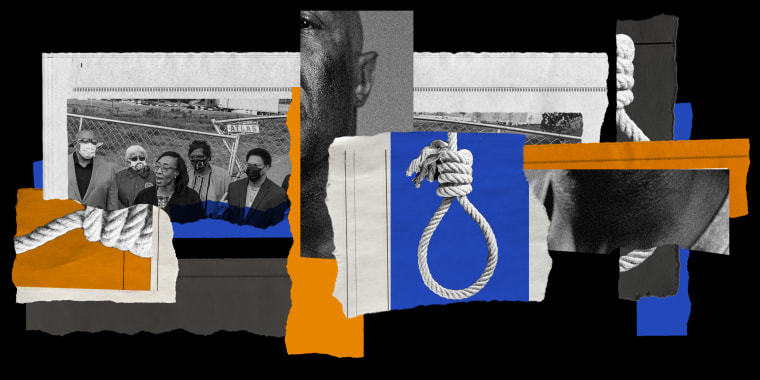In May, workers building a new Amazon facility in the town of Windsor, Connecticut, came across a noose on the property. It was the eighth noose they encountered since construction on the facility began in late 2020. The repeated occurrences forced Amazon to delay construction on several occasions and incited a great deal of tension among local residents. Close to 40 percent of the 28,733 residents in Windsor are Black, and about 9 percent of residents are Hispanic or Latino.
The appearance of these nooses has also sparked political organizing in recent months as workers in Windsor call attention to the racism they encounter on a day-to-day basis. During a news conference in May, Carlos Best, a foreman and iron worker, recounted witnessing symbols of hate on the site: “I did witness Confederate flags on people's hats, on the back of their cars. I personally heard racial remarks.”
In many ways, the noose is the quintessential, if deeply troubling, American symbol.
Despite the addition of new security cameras and a $100,000 offer from the company for any tips leading to an arrest, law enforcement officials have been unable to determine the source of the hateful symbols. As the FBI now works with the Windsor Police Department to locate the culprits, many residents and activists in Windsor are demanding Amazon and local officials take these developments seriously.
Their concerns mirror those of others across the nation. Since 2015, Black workers in various states — including Iowa, New Jersey, North Carolina and Maryland — have reported finding more than 50 nooses at construction sites, according to an analysis by The Washington Post.
The continued appearance of nooses in these workplaces — and in other private and public spaces — reveals much about the prevalence of racism in American life and culture. In many ways, the noose is the quintessential, if deeply troubling, American symbol. Its persistence in American life and culture today attests to the fact that white supremacist ideas have always been mainstream.
Nooses, which are associated with acts of lynching in the United States, are one of the prevailing symbols of hate, violence and white supremacy. Since the end of the Civil War, white supremacists have relied on nooses as a means of terrorizing Black people. While it is difficult to pinpoint exactly when the noose transitioned to being primarily viewed as the instrument of racial terror preferred by white supremacists, one thing is certain: Its popularity among hate groups coincided with Black Americans’ quest for expanded political rights and opportunities.
Much like the Confederate battle flag, which gained increasing popularity as Black Americans worked to improve their socioeconomic conditions, nooses have become a key weapon for those who resist racial equality. It is no wonder that members of the Ku Klux Klan frequently utilized the symbol during the 20th century as part of its nationwide campaign of racial terrorism. These symbols of hate send a powerful message to Black people and other marginalized groups, one of exclusion and racial subjugation — and impending violence.
According to Kidada E. Williams, associate professor of history at Wayne State University and the author of “They Left Great Marks on Me,” “The hangman’s noose is the most potent artifact of the history of lynching and other forms of racist violence in the U.S.”
“When racists hang them in public places,” Williams told me, adding, “they are communicating their belief in Black people’s disposability and invoking a history of its reality.”
The frequency of lynchings in the United States during the 19th and 20th centuries underscores why nooses extend far beyond mere symbols. While the victims of lynching varied, Black Americans represented the majority of those targeted by white assailants. According to researchers at the Equal Justice Initiative, an estimated 4,084 Black Americans were lynched from the period of 1877 to 1950. These violent acts primarily took place in the Southern region of the United States — states such as Alabama, Georgia, Louisiana and Mississippi. However, they were by no means isolated to the South.
Lynching was a national problem — one that Black activists were at the forefront of challenging. During the late 19th and early 20th centuries, Ida B. Wells-Barnett, one of the co-founders of the National Association for the Advancement of Colored People, or NAACP, emerged as one of the most prominent anti-lynching advocates in the nation.
Born in 1862, Wells-Barnett worked as a teacher in Memphis, Tennessee, before becoming a journalist. In 1895, she released her landmark study “The Red Record,” which denounced lynching and urged readers to call for a federal investigation into white mob violence. She went on to play an instrumental role in seeking federal anti-lynching legislation and protections for African Americans. As Wells-Barnett often pointed out in her writings, the practice of lynching was a “national crime” that was incompatible with the principles of freedom, justice and equality.
In a similar fashion, the symbol of the noose is contrary to the vision of an inclusive democracy. Those who utilize it in public and private spaces are unlikely to be oblivious to its meaning — and the terror it incites among Black Americans and other marginalized groups.
“Like their lynching forebears,” Williams reminded us, “the people who hang nooses in such public places as workplaces, schools, museums are using symbolism to project white supremacist power and intimidate Black and brown people.”
The power of the noose as an anti-democratic, racist symbol stretches far beyond the South, and the residents of Windsor are currently grappling with this history. These recent occurrences underscore how the legacy of lynching lives on as a “national crime.”

